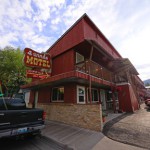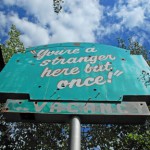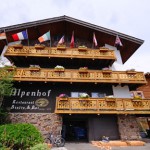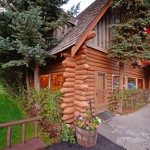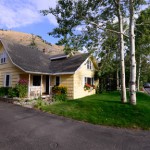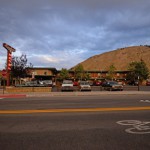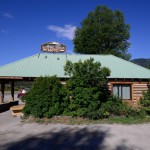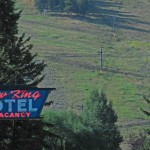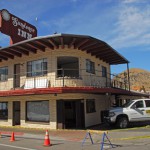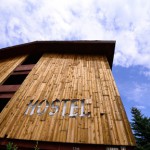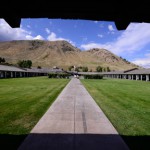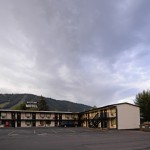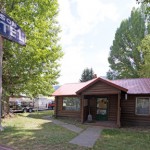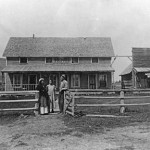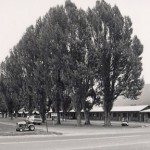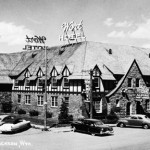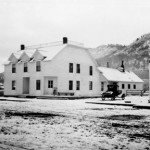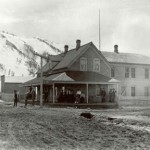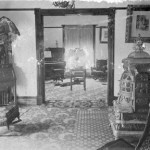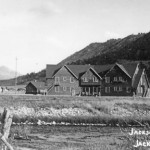Tourism in Teton County began soon after the first permanent settlement took place around 1883, when early settlers provided overnight accommodations to big game hunters and those curious and hardy enough to explore Yellowstone, the country’s first national park. Tourism gradually increased as roads and other infrastructure made the trip more comfortable in the early 1900s. The designation of the Grand Teton National Park in 1929 produced a dramatic increase in roadside accommodations. Teton County experienced a motel building boom during the 1950s and 1960s after the Grand Teton National Park expanded to its current boundaries. The historic period of tourist accommodations extends to 1969 when the ski industry had advanced to the point where tourism supported the economy in Teton County year round.
The historical context for tourism in Teton County includes many interconnected themes. The abundant wildlife and spectacular scenery that drew the first explorers and settlers also attracted the first tourists. The agricultural efforts of the settlers were often at odds with the politics of acquisition of the federal government in a county where currently only three percent of the land is privately held. Yet, the residents were also among the earliest and most influential conservationists in the county, preserving both the wildlife and the scenery. The first recreation in Teton County was enjoyed by the elite, but as the ranching culture took hold, a new kind of tourism based on America’s fascination with the “Old West” provided recreational and entertainment opportunities for nearly all socioeconomic classes, as well as commercial opportunities that supported many local residents during difficult times. Advances in transportation, especially paved roads beginning in the 1920s, brought more choices and more dimensions to the economy in the relatively isolated communities of Teton County.
The architectural and other historical resources that best represent more than a century of tourism in Teton County are the lodging properties. While representing a variety of architectural periods, these properties are linked by more than just a common pattern of usage. With very few exceptions, the buildings share a common material: wood. Log construction, whether out of necessity, tradition, or sometimes affectation, was ubiquitous. Wood siding in many of its rougher forms was popularly used to conjure the rugged era of the American West. Stylistically, the majority of architectural resources were influenced by the rustic style of early settlement construction and later by National Park Service building programs. Although many of the later motels conformed to the more modern style of architecture that suggested cleanliness and convenience, many retained lobbies, signage, or other elements that evoked the ambiance of western Americana. At the end of the historic period, the styles of the larger ski lodges evoked both the rustic West and an Alpine elegance.
-Excerpt from The National Register of Historic Places Multiple Property Documentation Form: Historic Tourist Accommodations in Teton County, Wyoming. Prepared by Korral Broschinsky
The Teton County Historic Preservation Board and the Jackson Hole Historical Society and Museum hosted a presentation about local historic hotels and motels by architectural historian, Korral Broschinsky, and an exhibit of Brian Herbel photography on Thursday, February 20th at 7:00 pm at the history museum, 225 N. Cache.
This exhibit was financed in part with funds granted to the Teton County Historic Preservation Board from the National Park Service, U.S. Department of the Interior. The Wyoming State Historic Preservation Office administers these federal funds as part of Wyoming’s Certified Local Government program. This program received Federal financial assistance for identification and protection of historic properties. The contents and opinions do not necessarily reflect the views or policies of the Dept. of the Interior. Under Title VI of the Civil Rights Act of 1964, Section 504 of the Rehabilitation Act of 1073, and the Age Discrimination Act of 1975, as amended, the U.S. Dept. of the Interior prohibits discrimination on the basis of race, color, national origin, sex, handicap, or age in its federally assisted programs. If you believe you have been discriminated against in any program, activity, or facility as described above, or if you desire further information, please write to: Office of Equal Opportunity, National Park Service, P.O. Box 37127, Washington, D.C. 20013-7127.
